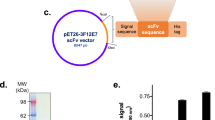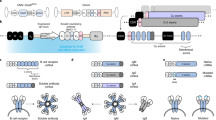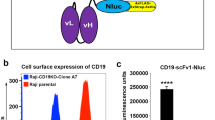Abstract
Single chain antibodies (scFv) represent powerful interventional agents for the achievement of targeted therapeutics. The practical utility of these agents have been limited, however, by difficulties related to production of recombinant scFv and the achievement of effective and sustained levels of scFv in situ. To circumvent these limitations, we have developed an approach to express scFv in vivo. An anti-erbB2 scFv was engineered for secretion by eukaryotic cells. The secreted scFv could bind to its target and specifically suppress cell growth of erbB2-positive cells in vitro. Adenoviral vectors expressing the cDNA for the secretory scFv likewise could induce target cells to produce an anti-tumor anti-erbB2 scFv. In vivo gene transfer via the anti-erbB2 scFv encoding adenovirus also showed anti-tumor effects. Thus, by virtue of engineering a secreted version of the anti-tumor anti-erbB-2 scFv, and in vivo expression via adenoviral vector, effective concentrations of scFv were achieved. In vivo gene transfer clearly represents a powerful means to realize effective scFv-based approaches. This method will likely have applicability for a range of disorders amenable to targeted therapeutic approaches.
This is a preview of subscription content, access via your institution
Access options
Subscribe to this journal
Receive 12 print issues and online access
$259.00 per year
only $21.58 per issue
Buy this article
- Purchase on Springer Link
- Instant access to full article PDF
Prices may be subject to local taxes which are calculated during checkout





Similar content being viewed by others
References
Hudson P.J. . Recombinant antibodies: a novel approach to cancer diagnosis therapy Expert Opin Invest Drugs 2000 9: 1231 1231
Jurcic J.G. . Antibody therapy of acute myelogenous leukemia Cancer Biother Radiopharm 2000 15: 319 319
Raag R., Whitlow M. . Single-chain Fvs FASEB J 1995 9: 73 73
Pavlinkova G. et al. Pharmacokinetics and biodistribution of engineered single-chain antibody constructs of Mab CC49 in colon carcinoma xenografts J Nucl Med 1999 40: 1536 1536
Stebbing E., Copson E., O'Reilly S. . Herceptin (trastuzamab) in advanced breast cancer Can Tr Rev 2000 26: 287 287
Poul M.A. et al. Selection of tumor-specific internalizing human anitbodies from phage libraries J Mol Biol 2000 301: 1149 1149
Klapper L.N., Waterman H., Sela M., Yarden Y. . Tumor-inhibitory antibodies to HER-2/ErbB-2 may act by recruiting c-Cbl and enhancing ubiquitination of Her-2 Cancer Res 2000 60: 2284 2284
Le X.F. et al. Differential signaling by an Anti-p185HER2 antibody and heregulin Cancer Res 2000 60: 3522 3522
Krasnykh V.N., Douglas J.T., van Beusechem V.W. . Genetic targeting of adenoviral vectors Mol Ther 2000 1: 391 391
Vanderkwaak T.J. et al. An advanced generation of adenoviral vectors selectively enhances gene transfer for ovarian cancer gene therapy approaches Gynecol Oncol 1999 74: 227 227
Krasnykh V.N. et al. Advanced generation adenoviral vectors possess augmented gene transfer efficiency based upon car-independent cellular entry capacity Cancer Res 2000 60: 6784 6784
Kay M.A. . Adenoviral vectors for hepatic gene transfer in animals Chest 1997 111: 138S 138S
Whittington H.A., Ashworth L.J., Hawkins R.E. . Recombinant adenoviral delivery for in vivo expression of scFv antibody fusion proteins Gene Therapy 1998 5: 770 770
Lam P.Y.P., Breakefield X.O. . Hybrid vector design to control the delivery, fate and expression of transgenes J Gene Med 2000 2: 395 395
King C.R., Fischer P.H., Rando R.F., Pastan I. . The performance of e23(Fv)PEs recombinant toxins targeting the erbB-2 protein Semin Cancer Biol 1996 7: 29 29
Haisma H.J. et al. Construction and characterization of a fusion protein of single-chain anti-CD20 antibody and human beta-glucuronidase for antibody-directed enzyme prodrug therapy Blood 1998 92: 184 184
Arafat W. et al. Antineoplastic effect of anti-erbB-2 intrabody is not correlated with scFv affinity for its target Cancer Gene Ther 2000 7: 1250 1250
Curiel D.T., Agarwal S., Wagner E., Cotten M. . Adenovirus enhancement of transferring–polylysine-mediated gene delivery Proc Natl Acad Sci USA 1991 1: 8850 8850
He T.C. et al. A simplified system for generating recombinant adenoviruses Proc Natl Acad Sci USA 1998 95: 2509 2509
Dmitriev I. et al. An adenovirus vector with genetically modified fibers demonstrates expanded tropism via utilization of a coxsackie virus and adenovirus receptor-independent cell entry mechanism J Virol 1998 72: 9706 9706
Author information
Authors and Affiliations
Rights and permissions
About this article
Cite this article
Arafat, W., Gómez-Navarro, J., Buchsbaum, D. et al. Effective single chain antibody (scFv) concentrations in vivo via adenoviral vector mediated expression of secretory scFv. Gene Ther 9, 256–262 (2002). https://doi.org/10.1038/sj.gt.3301639
Received:
Accepted:
Published:
Issue Date:
DOI: https://doi.org/10.1038/sj.gt.3301639
Keywords
This article is cited by
-
Anti-HER2 antibody therapy using gene-transduced adipocytes for HER2-positive breast cancer
Breast Cancer Research and Treatment (2020)
-
State of play and clinical prospects of antibody gene transfer
Journal of Translational Medicine (2017)
-
Enhancement of antitumor activity of gammaretrovirus carrying IL-12 gene through genetic modification of envelope targeting HER2 receptor: a promising strategy for bladder cancer therapy
Cancer Gene Therapy (2010)
-
In vivo evaluation of an EIAV vector for the systemic genetic delivery of therapeutic antibodies
Gene Therapy (2005)
-
Single-chain antibody and its derivatives directed against vascular endothelial growth factor: application for antiangiogenic gene therapy
Gene Therapy (2003)



